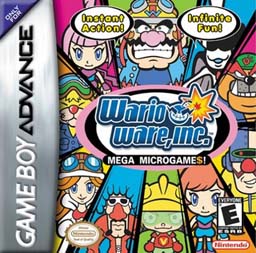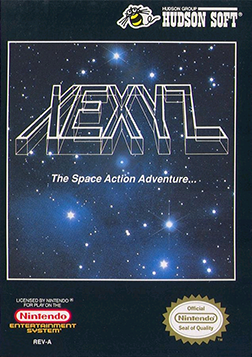
Sonic Advance, known as SonicN on the N-Gage, is a 2001 platform game developed by Dimps and published by Sega for the Game Boy Advance. It was the first Sonic the Hedgehog game released on a Nintendo console with Sonic Adventure 2: Battle on the GameCube, and was produced in commemoration of the series' tenth anniversary. The story follows Sonic, Tails, Knuckles, and Amy as they journey to stop Doctor Eggman from taking over the world. Controlling a character, players are tasked with completing each level, defeating Eggman and his robot army, and collecting the seven Chaos Emeralds.

WarioWare, Inc.: Mega Microgames!, stylized as WarioWare, Inc.: Mega Microgame$! and known as WarioWare, Inc.: Minigame Mania in the PAL region, is a minigame compilation video game developed and published by Nintendo for the Game Boy Advance. The debut title in the WarioWare series, the game is about rapid completion of "microgames", short minigames given to the player consecutively and with increasing speed per each game complete. The game's concept was inspired by the "Sound Bomber" mode of Mario Artist: Polygon Studio for the Nintendo 64DD. The music and sound effects were recycled from Wario Land 4. The game was produced by Takehiro Izushi and directed by Hirofumi Matsuoka. Matsuoka was also the director of Polygon Studio. Mega Microgames! was released in 2003; in Japan in March, in North America and Europe in May and in Australia in June.

The Pokémon Mini is a handheld game console that was designed and manufactured by Nintendo and themed around the Pokémon media franchise. It is the smallest game system with interchangeable cartridges ever produced by Nintendo, weighing just under two and a half ounces. It was first released in North America on November 16, 2001, and was only available for purchase at the Pokémon Center and via its website. This was followed by releases in Japan on December 14, 2001, and in Europe on March 15, 2002. The system was released in three colors: Wooper Blue, Chikorita Green, and Smoochum Purple.

Kirby's Adventure is a 1993 platform game developed by HAL Laboratory and published by Nintendo for the Nintendo Entertainment System (NES). It is the second game in the Kirby series after Kirby's Dream Land (1992) on the Game Boy and the first to include the Copy Ability, which allows the main character Kirby to gain new powers by eating certain enemies. The game centers around Kirby traveling across Dream Land to repair the Star Rod after King Dedede breaks it apart and gives the pieces to his minions.

Kirby Super Star, released as Kirby's Fun Pak in PAL regions, is an anthology platform video game developed by HAL Laboratory and published by Nintendo for the Super Nintendo Entertainment System in 1996. It is part of the Kirby series of video games by HAL Laboratory. The game was advertised as a compilation featuring eight games: seven short subsections with the same basic gameplay, and two minigames.

Mario's Cement Factory is a 1983 LCD game developed and published by Nintendo under their Game & Watch series. It follows earlier Mario games, like the arcade and Game & Watch versions of Donkey Kong. Players control Mario as he navigates elevators and funnels cement through a factory, while trying to prevent the cement from crushing his fellow workers. Two versions of the game were released — a Table Top unit and a handheld game akin to most other Game & Watch titles. Development was headed by Nintendo R&D1, led by engineer Gunpei Yokoi.

Banjo-Kazooie: Grunty's Revenge is a 2003 platform game by Rare for Nintendo's Game Boy Advance (GBA). It is the third instalment in the Banjo-Kazooie series and takes place between the events of the Nintendo 64 (N64) games Banjo-Kazooie (1998) and Banjo-Tooie (2000). In Grunty's Revenge, the evil witch Gruntilda travels back in time to prevent the events of Banjo-Kazooie from happening, and the bear Banjo and his bird friend Kazooie set out to stop her. Grunty's Revenge retains the focus on collecting items and most of the other game mechanics from its predecessors, but is presented in 2D rather than 3D. Aside from the main game, players can also access minigames such as fishing and target shooting.

Castlevania III: Dracula's Curse is an action-adventure platform video game developed and published by Konami for the Nintendo Entertainment System. It was released in Japan in 1989, and in North America in 1990, and in Europe by Palcom in 1992. It was later released on the Virtual Console for the Wii, Nintendo 3DS, and Wii U.

Marvel Land is a platform game released by Namco in arcades in 1990. It runs on the Namco System 2 hardware. The game was published for the Mega Drive in 1991, with the European version renamed Talmit's Adventure. The game shares its name with the fictitious kingdom where the 1986 Japan-only Famicom game Valkyrie no Bōken: Toki no Kagi Densetsu takes place, but has no connections with it otherwise. Likewise the game has no connections with Marvel Comics or any of their associated characters either. In December 2022, the arcade version of Marvel Land was re-released exclusively in Japan on the Nintendo Switch and the PlayStation 4 on the Arcade Archives lineup of digital arcade titles. It was originally planned for worldwide release at one point but was ultimately cancelled due to licensing issues with Disney and Hamster Corporation.

Kirby 64: The Crystal Shards is a 2000 platform game developed by HAL Laboratory and published by Nintendo for the Nintendo 64 (N64). It is the first Kirby game to feature 3D computer graphics and follows Kirby as he attempts to reassemble a sacred crystal shattered by Dark Matter. Gameplay is viewed from a 2.5D perspective and is similar to previous Kirby titles; the player traverses levels and obtains powers by eating enemies. Kirby 64 introduces Power Combos, the ability to mix powers to create more powerful ones. In a multiplayer mode, up to four players can compete in three minigames.

Densetsu no Stafy 4 is a platform video game developed by Tose and published by Nintendo for the Nintendo DS. It is the fourth game in The Legendary Starfy series. As with the other games in the series, Densetsu no Stafy 4 features Stafy, known as Starfy in Western regions, as the main character. He is joined by his sister Starly and his friend Moe the clam. The three of them help out other undersea creatures and fights numerous villains.

The Legendary Starfy is a video game series developed by Tose and published by Nintendo. The series is the only franchise for which Tose owns the copyright, which they share with Nintendo; as a result, Tose, which normally does not put their company name on their games, does so in the Starfy series. The series began in 2002 with Densetsu no Stafy for the Game Boy Advance, and four sequels were released. For its first seven years, Starfy games were not released outside Japan. The fifth and latest game in the series was released as The Legendary Starfy in North America on June 8, 2009.

Xexyz, known in Japan as Kame no Ongaeshi - Urashima Densetsu, is a 1988 video game published by Hudson Soft for the Nintendo Entertainment System. The game was released in Japan on August 26, 1988, and saw a North American release sometime in April 1990. The game was never released in Europe and the game is not playable on PAL consoles.

Tose Co., Ltd. is a Japanese video game development company based in Kyoto. It is mostly known for developing Nintendo's Game & Watch Gallery series, various Dragon Ball games, as well as other Nintendo products. Tose has developed or co-developed over 1,000 games since the company's inception in 1979, but is virtually never credited in the games themselves. Tose maintains a policy of having no creative input into the work they do, going so far as to refuse to put their names in the credits for most of the games they work on. As such, Tose has gained a reputation for being a "ghost developer".

Densetsu no Stafy is a platform video game developed by Tose and published by Nintendo for the Game Boy Advance system exclusively in Japan on September 6, 2002. It is the first game in the series The Legendary Starfy.

Densetsu no Stafy 2 is a platform video game developed by Tose and published by Nintendo for the Game Boy Advance in Japan on September 5, 2003. It is the second game in The Legendary Starfy series.

Nintendo Software Planning & Development Division, commonly abbreviated as Nintendo SPD, was a Japanese research, planning and development division owned by Nintendo and housed inside the Nintendo Development Center in Kyoto, Japan. The division had two departments: Software Planning & Development Department, which primarily co-produced games with external developers; and Software Development & Design Department, which primarily developed experimental and system software. The division was created during a corporate restructuring in September 2003, with the abolition of the Nintendo R&D1 and Nintendo R&D2 departments.

The Legendary Starfy, known as Densetsu no Stafī: Taiketsu! Daīru Kaizokudan in Japan, is a 2008 platform video game developed by Tose and published by Nintendo for the Nintendo DS handheld video game console. It is the fifth game in The Legendary Starfy video game series. On June 8, 2009, the game became the first, and so far the only, in the series to be released outside Japan.

Rotohex is a Nintendo video game for the Wii's WiiWare service. It is a remake of the Japan-only bit Generations title Dialhex. It was released as WiiWare in North America on October 27, 2008.

Mighty Flip Champs! is a puzzle-platform game, developed and published by WayForward Technologies for the Nintendo DSi's DSiWare digital download service. It was released on June 1, 2009, in North America and on November 27 in the PAL regions. The developers took inspiration from multiple sources, including the video games Wendy: Every Witch Way and The Legend of Zelda: A Link to the Past. In it, players control Alta, a girl who has to reach a fishman by flipping between areas until she can reach him. Since its release, Mighty Flip Champs! received all-around positive reception, while also being called one of the best video games for the DSiWare service. It is the first game in the Mighty series, and is followed by Mighty Milky Way, Mighty Switch Force! and Mighty Switch Force! 2.





















